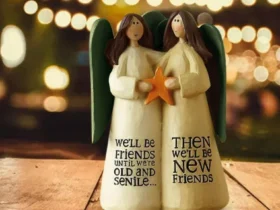Love is a universal language, and Valentine’s Day is a celebration that embraces the spirit of affection, romance, and devotion. One of the intriguing aspects of this special day lies in the symbolic representation of love through various Valentine symbols. In this article, we will unravel the secrets behind these symbols and explore their profound meanings. Join us on this journey of discovery as we delve into the enchanting world of Valentine’s symbols and their significance in the language of love.
Contents
What are the Symbols of Valentine’s Day?
Valentine’s Day is rich in symbolism, with Valentine symbols carrying deep meaning. The heart shape represents profound emotions and connections between individuals. Cupid, the Roman god of love reinforces the idea of a day dedicated to love and romance.
Red roses, classic symbols of love and passion, are exchanged as tokens of affection, while love birds, such as doves remind us of the strong bonds between people. While unique gifts and traditions may vary, the heart, Cupid, roses, and love birds continue to evoke the spirit of love and romance on Valentine’s Day.

The Meanings Of Valentine Symbols
Valentine’s Day is a celebration that brims with symbolism, and understanding the meanings behind its symbols adds depth and significance to this special occasion. Let’s explore some of the most iconic symbols of Valentine’s Day and unravel their profound meanings.
Heart – The Universal Valentine’s Day Symbols of Love
The heart Valentine symbols has become synonymous with love and passion, making it the universal emblem of Valentine’s Day. Its distinctive shape, often portrayed in vibrant red, is instantly recognizable and evokes feelings of warmth and affection.
The heart is a powerful visual representation of the love that binds individuals together, transcending language and cultural barriers. It symbolizes the emotional core of relationships, expressing the depths of affection, devotion, and romantic connection.

Beyond its association with romantic love, the heart symbol encompasses a broader spectrum of emotions. It represents compassion, empathy, and the love shared between friends, family, and even oneself. The heart symbolizes the capacity to care deeply for others, to understand and support them in times of joy and sorrow.
The heart symbol’s enduring popularity on Valentine’s Day is a testament to its timeless appeal. Its presence can be found in various forms of art, literature, and cultural traditions throughout history.
From ancient civilizations to contemporary society, the heart as one of the popular Valentine symbols has remained a powerful and universally understood representation of love. It has the remarkable ability to evoke strong emotions and create a sense of connection and unity among people.
Who is Cupid? – The Mischievous Valentines Day’s Symbol
Cupid, the mischievous cherubic figure armed with a bow and arrow, is an iconic symbol associated with Valentine’s Day. In mythology, Cupid is often depicted as a playful and mischievous character who has the power to make people fall deeply in love. His arrows are said to ignite the flame of desire and stir affectionate emotions in the hearts of those struck by them.
Cupid’s presence as one of Valentine symbols reminds us of the unpredictable and whimsical nature of love. It serves as a whimsical symbol that captures the enchantment and excitement of falling in love, encouraging us to embrace the magic and spontaneity that love can bring.

Cupid’s mischievous charm adds a sense of adventure and spontaneity to the celebration of Valentine’s Day. He represents the unexpected encounters and serendipitous moments that can lead to profound connections with others. Cupid reminds us that love has the power to transform lives and bring joy and fulfillment. His presence encourages us to be open to love’s surprises and to take risks in matters of the heart.
Cupid’s image has been depicted in art, literature, and popular culture throughout history, making him an enduring symbol of love and romance. His cherubic appearance, with his wings and bow, evokes a sense of innocence and purity. Cupid’s representation on Valentine’s Day serves as a playful reminder to celebrate love in all its forms.
What Does a Red Rose Mean on Valentine’s Day?
Roses have long been Valentine symbols associated with love and romance, making them timeless symbols of Valentine’s Day. Their beauty, fragrance, and delicate petals have captivated hearts and inspired poets and artists throughout history.
>>> Read more: 30+ Heartfelt Valentines Day Presents
The rose symbolizes not only romantic love but also beauty, passion, and emotional depth. It serves as a visual representation of the profound emotions and sentiments that love can evoke. When gifted on Valentine’s Day, roses carry a message of deep affection and serve as a timeless expression of love that transcends words.

Each color of the rose carries its symbolic meaning, allowing individuals to convey specific emotions and messages through their choice of flowers. Red roses, the most popular choice on Valentine’s Day, symbolize passionate love and desire. Pink roses signify admiration, gratitude, and gentleness, making them ideal for expressing appreciation and affection. White roses represent purity, innocence, and new beginnings, making them a symbol of young love or the start of a new chapter in a relationship.
The timeless Valentine symbols extend beyond its colors. The act of giving roses is a gesture that transcends time and holds cultural significance. It is a gesture of thoughtfulness, care, and love. Presenting a bouquet of roses to a loved one on Valentine’s Day is a tradition that has been cherished for generations.
The delicate petals and intoxicating fragrance of the rose create a sensory experience that enhances the expression of love. The timeless beauty of roses serves as a reminder to cherish the fleeting moments of love and to appreciate the beauty that exists within relationships.
Meanings of Other Small Valentine’s Symbols
While hearts, Cupid, and roses are commonly associated with Valentine’s Day, other small symbols can add a touch of uniqueness to the celebration. For example, the love knot is a symbol of eternal love and commitment. It is often depicted as two intertwined knots, representing the unbreakable bond between two individuals.

Another lesser-known symbol is the key, which symbolizes unlocking someone’s heart and trust. Giving a key as a gift can be a symbolic gesture of opening oneself up to love. These alternative symbols offer a fresh perspective on expressing love and can make Valentine’s Day celebrations even more special.
Which is the Most Famous Valentine Symbol?
The most famous Valentine’s symbol is undoubtedly the heart. The heart shape has become synonymous with love and affection, and it is universally recognized as a symbol of romance and emotions.
Whether it’s a heart-shaped chocolate box, a heart-shaped balloon, or a heart-shaped card, this iconic symbol is deeply ingrained in Valentine’s Day traditions worldwide. Its simple yet powerful design captures the essence of love, making it the most recognizable and beloved Valentine symbol.
Facts about Valentine’s Day Symbols
These unique and fun facts about Valentine symbols add a bit of intrigue and fascination to the holiday’s traditions.
- The heart shape we commonly associate with love and Valentine’s Day is believed to have been inspired by the shape of the buttocks of a now-extinct species of giant ground sloth.
- In addition to red roses, yellow roses are also associated with Valentine’s Day. They symbolize friendship and joy, making them a popular choice for platonic expressions of affection.
- Cupid wasn’t always depicted as a cherubic child. In ancient Roman mythology, Cupid was portrayed as a young man, often blindfolded, representing the unpredictable nature of love.
- Lovebirds are not just a symbol of love, but they are also known for their unique behavior of feeding each other as a sign of affection and courtship.

- Love letters have been around for centuries, but did you know that St. Valentine himself wrote the first Valentine’s Day card? Legend has it that he wrote a note to his jailer’s daughter, signing it “From your Valentine,” which is a phrase still used today.
- The tradition of giving chocolates on Valentine’s Day can be traced back to the 1800s when Richard Cadbury introduced the first Valentine’s Day chocolate box. He designed the box with beautiful artwork so that it could be kept as a memento even after the chocolates were eaten.
- The concept of love knots, Valentine symbols of everlasting love, originated in the Middle Ages. Sailors would give their sweethearts love knots made from ropes as a token of their affection and a promise to return safely from their voyages.
- Doves have been associated with love and fidelity since ancient times. In Roman mythology, doves were sacred to Venus, the goddess of love, and were believed to bring blessings of love and peace.
Conclusion
Valentine symbols serve as a powerful medium of expression, allowing individuals to communicate their deepest emotions and sentiments. From the enduring heart symbol to the mischievous Cupid and the timeless beauty of roses, these symbols have captivated lovers throughout history. Understanding the meanings behind these symbols adds depth and significance to the celebration of Valentine’s Day. As we continue to cherish and honor this day of love, let us embrace the language of Valentine’s symbols and the profound messages they convey.











